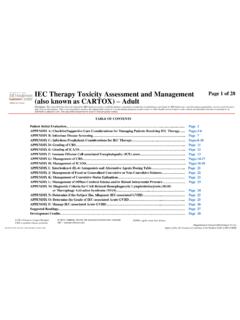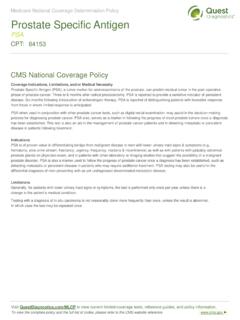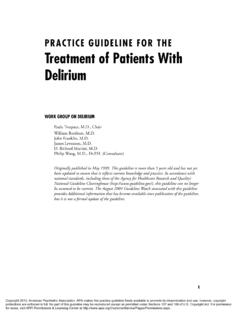Transcription of Symptom Management Guidelines: CARE OF MALIGNANT …
1 Symptom Management Guidelines: CARE OF MALIGNANT WOUNDS Definition MALIGNANT wounds are the result of cancerous cells infiltrating the skin and its supporting blood and lymph vessels causing loss in vascularity leading to tissue death. The lesion may be a result of a primary cancer or a metastasis to the skin from a local tumour or from a tumour in a distant site. It may take the form of a cavity, an open area on the surface of the skin, skin nodules, or a nodular growth extending from the surface of the skin.
2 A MALIGNANT wound may present with odour, exudate, bleeding, pruritis and pain and interfere with quality of life. MALIGNANT wounds occur in 5%-10% of patients with metastatic disease, most often in the last six months of life. Factors to Consider When Managing MALIGNANT Wounds Evidence and Guidelines Treatment of ulcerating and fungating wounds secondary to malignancy represents a clinical challenge given the paucity of evidence-based guidelines or established protocols Managing MALIGNANT wounds is frequently based on expert opinion and the personal experiences of clinicians Irrespective of the nature and requirements for managing the wound.
3 The individual s wishes and expectations should form the basis of the decision-making process Medical History Cancer Diagnosis and Co-morbidities Breast cancer (deep necrotic ulcerations or extensive cutaneous chest wall infiltration and necrotic cauliflower like structures) Ovary, cecum, rectum cancers (abdominal wall invasion with necrotic cauliflower like structures) Rectum and genitourinary tract cancers can cause protruding perineal growth, gross deformity and loss of normal function potential for fistulas involving bladder bowel and vagina Head and neck cancers (distortion of the face, fistulas, potential bleeding) Chronic Obstructive Pulmonary Disease Heart Disease Anemia Diabetes Mellitus Compromised Immune System Advanced age Tobacco use Nutritional Status Malignancy alone can compromise nutritional status.
4 patients who are poorly nourished may be at risk for poor wound healing and Management Psychosocial Impact The location, appearance and/or odour of a MALIGNANT wound may be a source of distress for both the patient and family. Depression, social isolation and anxiety can occur within this population The assessment of a MALIGNANT wound requires the nurse to gain insight into the patient s perception of the wound and its consequent impact on his/her life Nursing care requires counseling skills and knowing how to provide care that is based on an awareness of and insight into the patients experience Previous treatments and medications Previous surgery.
5 Chemotherapy and radiation may all have an impact on the care and Management of the wound Medications such as non-steroidal anti-inflammatory drugs and systemic corticosteroids Availability of Resources and Social Network Dressing supplies can be expensive and may not be readily available Family and friends may be relied upon to help care for MALIGNANT wounds The information contained in these documents is a statement of consensus of BC Cancer Agency professionals regarding their views of currently accepted approaches to treatment.
6 Any clinician seeking to apply or consult these documents is expected to use independent medical judgement in the context of individual clinical circumstances to determine any patient's care or treatment. Use of these documents is at your own risk and is subject to BC Cancer Agency's terms of use, available at Page 1 of 7 Focused Assessment GENERAL ASSESSMENT Symptom ASSESSMENT PHYSICAL ASSESSMENT Contact & General Information Physician name - oncologist, general practitioner (GP) Pharmacy (if applicable)
7 - name and contact information Home health care (if applicable) name and contact information Consider Contributing Factors Cancer diagnosis (site) Cancer treatment: date of last treatment/s, concurrent treatments, Co-morbidities Nutritional status Recent lab or diagnostic reports Normal Have you noticed any changes to your wound? What have you been doing to care for your wound? Onset How long have you had this wound? Provoking / Palliating What makes it feel better or worse?
8 Quality (in the last 24 hours) Do you feel that the plan for caring for your wound has been effective (type of dressing, cleansing of wound) Region What areas are affected? Severity / Other Symptoms Since your last visit, how would you rate the discomfort associated with your wound? between 0-10? What is it now? At worst? At best? On average? Have you been experiencing any other symptoms: fever, discharge, bleeding, odour. Treatment How have you been managing the wound? Are you currently using any medications?
9 How effective are they? Any side effects? Understanding / Impact on You Is your wound and treatment impacting your activities of daily living (ADL)? Is your wound impacting your relationships with family and friends? Do you require any support to (family, home care nursing) care for your wound? Are you having any difficulty sleeping, eating, drinking? Value What is your comfort goal or acceptable level for this Symptom ? Vital Signs As clinically indicated Assessing Wound Location Size of area Colour (black/necrotic, green/yellow sloughy) Depth (superficial/deep/layers involved) Signs of infection local or systemic (see Appendix A) Exudate (colour, amount)
10 Presence or absence of odour Description and intensity of pain Signs of fistula/sinus formation Presence or absence of bleeding Presence or absence of pruritis Condition of surrounding skin Ease and effectiveness of dressing protocol The information contained in these documents is a statement of consensus of BC Cancer Agency professionals regarding their views of currently accepted approaches to treatment. Any clinician seeking to apply or consult these documents is expected to use independent medical judgement in the context of individual clinical circumstances to determine any patient's care or treatment.














